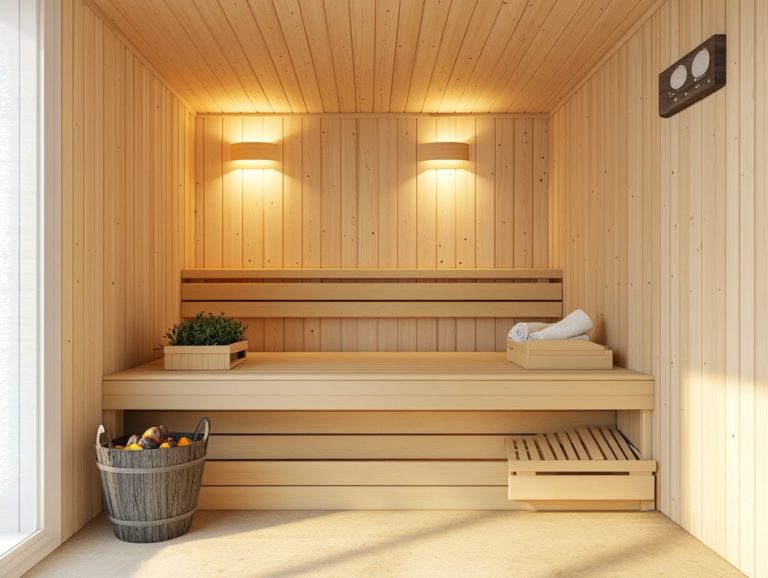“How to Choose Between Traditional and Infrared Saunas”
Are you ready to enhance your wellness routine with a sauna? Are you thinking about incorporating a sauna but feeling torn between traditional and infrared options? Each type presents unique benefits, making this decision both thrilling and somewhat daunting.
This article explores the health benefits of traditional and infrared saunas. We ll highlight key differences in heat, humidity, cost, and maintenance.
By the end of this article, you ll know how to choose the sauna that fits your lifestyle.
Contents
- Key Takeaways:
- Benefits of Traditional Saunas
- Benefits of Infrared Saunas
- Factors to Consider When Choosing a Sauna
- Differences in Heat and Humidity Levels
- Which Sauna is Right for You?
- Frequently Asked Questions
- What are the key differences between traditional and infrared saunas?
- Which type of sauna is better for relaxation and detoxification?
- Can people with sensitive skin use both types of saunas?
- What are the maintenance differences between traditional and infrared saunas?
- Which type of sauna is more energy efficient?
- Is there a difference in cost between traditional and infrared saunas?
Key Takeaways:

- Consider your budget, space, and maintenance requirements when choosing between traditional and infrared saunas.
- Traditional saunas offer both physical and mental health benefits, while infrared saunas use heat to target specific areas of the body for therapeutic benefits.
- The key difference between traditional and infrared saunas is the level of heat and humidity. Traditional saunas are hotter and more humid. Assess your needs and preferences to determine which type of sauna is right for you.
What are Traditional and Infrared Saunas?
Traditional and infrared saunas have become quite the sensation, each offering its own unique approach to heat therapy a method to help you relax and feel better and a myriad of health benefits, including detoxification, relaxation, and an uplifted emotional state.
With roots tracing back centuries, traditional saunas emerged in Finland, emphasizing a steam-filled environment that encourages sweating and promotes detoxification. On the other hand, infrared saunas leverage advanced technology to emit infrared light that goes deep into your skin. This method provides gentler heat exposure, directly targeting your muscles and joints. When considering a sauna, it’s important to know how to choose a safe location for your sauna.
This innovative approach not only amplifies the detox process but also brings specific health advantages such as pain relief, enhanced circulation, and support for cardiovascular health. To optimize these benefits, learn how to choose a sauna based on your health. Both sauna types create a serene atmosphere, allowing you to unwind and relieve stress, ultimately elevating your emotional well-being.
Benefits of Traditional Saunas
The benefits of traditional saunas go well beyond simple relaxation; they offer a remarkable range of health advantages. You ll experience enhanced cardiovascular response, improved blood circulation, and increased sweating, which plays a vital role in detoxifying your body.
Regular sauna sessions have been associated with a reduced risk of heart disease and an overall boost in well-being, making them an essential component of any comprehensive wellness routine.
Physical and Mental Health Benefits
Traditional saunas present remarkable physical and mental health advantages. These include relief from chronic pain, enhancements in mental clarity, and effective adaptations to stress all contributing to an uplifted mood. The heat in a traditional sauna prompts the release of endorphins, boosting your emotional well-being and offering a natural pathway to relaxation.
You may notice a significant reduction in symptoms related to conditions like arthritis and fibromyalgia after incorporating regular sauna visits into your routine. The soothing warmth not only alleviates muscle tension but also improves circulation, making it an invaluable resource for easing persistent discomfort.
Beyond physical benefits, the serene environment encourages mindfulness, allowing you to process and manage your thoughts more effectively. Many individuals find that their weekly sauna ritual brightens their mood and equips them with better coping strategies for daily stressors, helping maintain emotional balance in today s fast-paced world.
Benefits of Infrared Saunas

Infrared saunas stand out for their remarkable health benefits, offering enhanced detoxification, deep relaxation, cellular repair, and hormonal regulation. It’s no wonder they ve become a favored choice among wellness enthusiasts.
Distinct from traditional saunas, infrared saunas harness the power of infrared light to penetrate more deeply into the body, delivering a more efficient and effective approach to promoting overall health and well-being.
Experience the powerful health benefits of infrared saunas today. They can transform your wellness journey!
How Infrared Heat Works on the Body
Infrared heat penetrates the skin, promoting a body’s reaction that enhances cellular repair and detoxification while providing a relaxing experience. Infrared saunas are an incredibly energy-efficient choice that can transform your wellness journey. With this unique mechanism, you can enjoy the benefits of heat exposure without the oppressive temperatures often found in traditional saunas.
By delivering targeted warmth, infrared heat stimulates the repair of damaged cells and boosts circulation, which is essential for optimal cellular function. As these wavelengths interact with your body s tissues, they encourage the production of antioxidants, further aiding in detoxification. This natural interaction helps your body efficiently eliminate toxins, leading to improved overall health and well-being.
Many users report experiencing reduced muscle tension and stress relief, showcasing the extensive benefits of this innovative therapy. As you seek more energy-efficient and holistic health solutions, infrared technology is a standout option that paves the way toward achieving your wellness goals. To further enhance your understanding, explore what are the differences between saunas and their unique benefits.
Factors to Consider When Choosing a Sauna
When considering whether to invest in an infrared sauna or a traditional sauna, several key factors demand your attention.
Cost, maintenance requirements, and space considerations all play crucial roles in shaping your overall sauna experience.
By grasping these elements, you can make a well-informed decision that harmonizes with your health goals and lifestyle preferences.
Cost, Maintenance, and Space Requirements
Cost, maintenance, and space requirements are essential factors to consider when selecting between an infrared sauna and a traditional sauna. These elements can significantly impact not just your budget but also the practicality of installation in places like health centers, spas, or gyms.
When evaluating costs, keep in mind that infrared saunas often come with lower initial expenses and operational costs due to their energy efficiency. This makes them a compelling choice for commercial settings.
On the other hand, traditional saunas typically demand a higher investment for both installation and ongoing electricity, as they require more energy to heat up.
Regarding upkeep, infrared models generally require less frequent maintenance since they have fewer mechanical parts. In contrast, traditional saunas may need regular inspections and repairs due to their more complex heating systems. For more guidance, check out these practical tips for choosing a home sauna.
The choice of sauna can also be heavily influenced by the space you have available; infrared units tend to be more compact and flexible in design, making them ideal for smaller facilities. If you’re unsure about which option is best for you, check out how to find the right sauna for your needs. Traditional saunas, however, usually need a larger footprint to function optimally.
Differences in Heat and Humidity Levels

Grasping the distinctions in heat and humidity levels between infrared saunas and traditional saunas is crucial for curating the ideal sauna experience tailored to your preferences.
Traditional saunas generally operate at higher humidity and temperatures, which can feel intense. In contrast, infrared saunas offer a more manageable heat exposure, enabling you to enjoy extended sessions without the discomfort that often accompanies higher temperatures. If you’re considering adding one to your home, check out the best types of saunas for home use.
How Traditional and Infrared Saunas Differ in Heat and Humidity
Traditional saunas generate steam, creating high humidity. Infrared saunas heat your body directly, leading to a drier atmosphere. This difference significantly influences your comfort and the overall effectiveness of your experience. While traditional saunas offer an enveloping warmth and soothing steam, infrared saunas focus on enhancing your emotional wellbeing and making your sauna time more enjoyable.
This distinction is crucial when deciding between the two options. Your comfort and relaxation can be greatly impacted. If you enjoy the traditional sauna’s ritual and opportunities for social interaction, it might be the right choice for you. However, if you feel claustrophobic or overwhelmed by humidity, how to set up a home sauna provides a more manageable alternative, allowing for easier breathing and a customized heat experience.
Many users report feeling calmer, experiencing reduced anxiety, and enjoying a revitalized spirit. This underscores the importance of choosing the sauna that aligns best with your personal wellness journey.
Which Sauna is Right for You?
Selecting the perfect sauna whether it s an infrared sauna or a traditional one hinges on your unique needs and preferences. Consider the distinct health benefits each type provides. For instance, traditional saunas can improve circulation and relaxation, while infrared saunas may assist in muscle recovery and skin health.
Personal comfort, specific health conditions such as chronic fatigue syndrome, and your goals for relaxation should guide your decision-making process when exploring different sauna styles.
Assessing Your Needs and Preferences
Assessing your needs and preferences is essential when choosing between an infrared sauna and a traditional sauna. Your wellness goals and lifestyle play a pivotal role in this decision. Consider what you aim to achieve whether it’s relaxation, removing toxins from the body, or enhanced cardiovascular health. This understanding will lead you to the sauna type that aligns best with your expectations.
It’s crucial to weigh the various benefits and features each option presents. For example, infrared saunas typically operate at lower temperatures, making them a great fit for those who enjoy a gentler experience. In contrast, traditional saunas deliver that classic, invigorating heat many people crave. To ensure a positive experience, it’s also important to know how to choose a safe sauna environment.
Personal space requirements and how the sauna fits into your daily routine can significantly shape your choice. By evaluating these factors, you can ensure you select a sauna that aligns with your specific health goals and overall lifestyle, maximizing your wellness journey!

Frequently Asked Questions

What are the key differences between traditional and infrared saunas?
Traditional saunas use heated rocks or stoves to produce high temperatures, while infrared saunas use infrared heaters to directly heat the body. Traditional saunas typically reach temperatures between 150-195 F, whereas infrared saunas operate at a lower temperature range of 120-150 F.
In summary, traditional saunas focus on steam and high heat, while infrared saunas target the body directly with less heat.
Which type of sauna is better for relaxation and detoxification?
Both traditional and infrared saunas offer relaxation and detoxification benefits. However, many believe infrared saunas are more effective due to their ability to penetrate deeper into the skin and produce a more intense sweat.
This makes infrared saunas particularly popular among those seeking a more vigorous detoxifying experience.
Can people with sensitive skin use both types of saunas?
Yes, individuals with sensitive skin can use both traditional and infrared saunas. However, traditional saunas may be more drying due to the higher temperatures. Staying hydrated and moisturized after using a traditional sauna is essential.
Ultimately, both options can be enjoyable, but it’s important to listen to your body s needs.
What are the maintenance differences between traditional and infrared saunas?
Traditional saunas require regular cleaning and maintenance of the heating elements and rocks. In contrast, infrared saunas do not have heating elements to clean. Both types require periodic replacement of bulbs or heating elements, but infrared saunas generally have a longer lifespan.
This makes infrared saunas a lower-maintenance option for many users!
Which type of sauna is more energy efficient?
Infrared saunas are typically more energy efficient than traditional saunas. This is because they operate at lower temperatures and have shorter warm-up times.
However, both saunas can save energy with good insulation and smart usage habits.
Is there a difference in cost between traditional and infrared saunas?
While traditional saunas can have a lower purchase price, their maintenance and energy costs may add up over time.
Infrared saunas might include features like special lighting that enhances your mood, which can influence the overall price.






